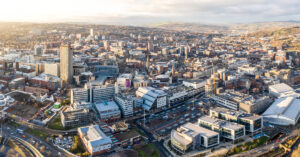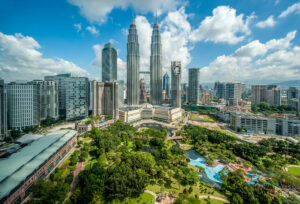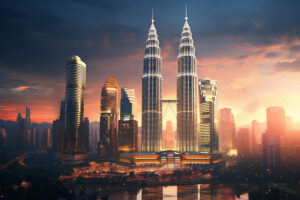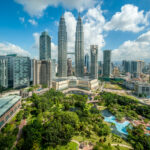Healthy city design is transforming urban landscapes in Malaysia, promoting active lifestyles and enhancing quality of life. This approach focuses on creating cities that promote physical activity, social interaction, and mental well-being through carefully designed living spaces.
By prioritising walkability, green spaces, mixed-use development, and active transportation, Malaysian cities can be more livable and sustainable.
Therefore, in this article, we explore key elements of healthy city design, its benefits for Malaysian communities, and its impact on urban landscapes.
Key Elements of Healthy City Design

1. Walkability and Connectivity
Malaysia’s National Urbanisation Policy emphasises the importance of walkability and connectivity in urban areas.
Building wider sidewalks, dedicated bike lanes, and easily connected streets can encourage people to walk and bike more. Consequently, these infrastructure improvements enhance physical health, reduce traffic congestion, and decrease air pollution in cities.
2. Green Spaces and Parks
Furthermore, the Malaysian government values green spaces in urban areas, targeting 2 hectares per 1,000 urban residents. Expanding parks and green spaces helps improve air quality, promote physical activity, and enhance community well-being.
These efforts create livable and sustainable cities, ensuring future generations can enjoy the benefits of urban green spaces.
3. Mixed-Use Development
Mixed-use development is also gaining traction in Malaysia as a means of creating vibrant, self-sufficient communities.
It reduces long commutes, boosts local businesses, and creates a strong community spirit. These benefits are in line with the government’s goal of building smart cities that prioritise good living and sustainability.
4. Active Transportation Infrastructure
Malaysia also invests in active transportation infrastructure, such as dedicated bicycle lanes, secure bicycle parking, and funding bicycle-sharing start-ups. These initiatives promote healthy lifestyles and reduce reliance on petrol-powered vehicles.
The Iskandar Malaysia Ecomobility Project is an excellent example of how cities can encourage active transportation by providing sustainable infrastructure.
Read More: From Carbon to Clean: Malaysia’s Journey to Low-Carbon Cities
Benefits of Healthy City Design
The implementation of healthy city design principles offers a wide range of benefits for Malaysian communities, such as:
1. Improved Public Health
Firstly, living in a neighbourhood with great pedestrian and cycling infrastructure can significantly boost physical activity levels. This consequently means lower risks of obesity, cardiovascular diseases, and other health issues.
2. Enhanced Mental Well-being
Moreover, exposure to green spaces and natural surroundings positively impacts mental well-being. Research has linked access to these areas with reduced stress, anxiety, and depression levels.
This suggests that incorporating nature into urban environments can promote better mental health outcomes for city dwellers. Hence, by prioritising the integration of green spaces into urban planning, Malaysian cities can foster the mental well-being of their residents.
3. Stronger Social Cohesion
Additionally, well-designed public spaces and mixed-use neighbourhoods provide opportunities for social interaction and community building. These spaces encourage people to gather and engage with one another, fostering a sense of belonging within urban communities.
Essentially, healthy city design strengthens social bonds by creating inviting and inclusive public areas. Community activities in these spaces also promote social cohesion and a shared sense of identity as Malaysians.
Read More: Climate-Smart Cities in Malaysia: A Response to Climate Change
Building a Sustainable Future with PEQ Consult
In conclusion, healthy city design principles are transforming Malaysian urban landscapes into active, liveable communities that promote well-being and sustainability.
Urban planning is essential for improving the well-being of city dwellers and developing intelligent, adaptable urban areas. To accomplish this, urban planners focus on creating pedestrian-friendly environments, incorporating green spaces, and promoting mixed-use development.
Embrace the benefits of healthy city design by partnering with PEQ Consult to create thriving, sustainable communities in your city.
Contact us today to learn more about our urban planning services and how we can help you build active, liveable cities across Malaysia.













